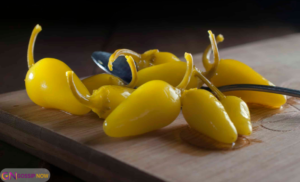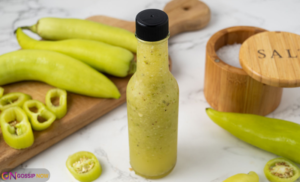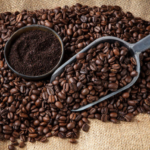Banana peppers, with their distinctive shape and tangy flavor, are a versatile ingredient used in various dishes worldwide. These peppers belong to the Capsicum genus and can add a mild heat to your meals, making them perfect for salads, sandwiches, and even stuffed appetizers. In this article, we’ll dive deep into the world of banana pepper, exploring their benefits, popular recipes, and how they compare to other pepper varieties like pepperoncini.
What Are Banana Peppers?
 Banana_peppers are long, yellow peppers that resemble bananas in shape, hence the name. They are typically mild in heat, ranging from 0 to 500 Scoville heat units (SHU), making them a popular choice for those who want a little kick without overwhelming heat. Banana_peppers can be eaten raw, pickled, or cooked, and they add a slight tanginess and crunch to dishes.
Banana_peppers are long, yellow peppers that resemble bananas in shape, hence the name. They are typically mild in heat, ranging from 0 to 500 Scoville heat units (SHU), making them a popular choice for those who want a little kick without overwhelming heat. Banana_peppers can be eaten raw, pickled, or cooked, and they add a slight tanginess and crunch to dishes.
Types of Banana Peppers
While banana_peppers are most commonly yellow, they can also be found in orange, red, or green. The flavor may change slightly depending on the pepper’s maturity. For example, green banana peppers are typically milder, while red ones are more flavorful and sweet. The most common types of banana_peppers include:
-
Sweet Banana Pepper: These are the most commonly available and have a mild, sweet flavor.
-
Hot Banana Pepper: These are spicier than sweet varieties and can be used to add heat to various recipes.
Banana Pepper vs Pepperoncini: What’s the Difference?
At first glance, banana_peppers and pepperoncini peppers might seem similar, but they have distinct differences. Here’s a comparison between the two:
-
Shape & Size: Banana_peppers are generally longer and can be more curved, resembling the shape of a banana. Pepperoncini, on the other hand, are smaller, often wrinkled, and more tapered.
-
Flavor: Banana_peppers are milder and slightly sweeter than pepperoncini. Pepperoncini peppers tend to have a more tangy and bitter taste.
-
Heat Level: Banana_peppers generally fall between 0 to 500 SHU, while pepperoncini peppers range from 100 to 500 SHU. This makes banana_peppers slightly milder, although the difference is minimal.
-
Uses: Both peppers are often pickled, but banana_peppers are commonly used in salads and sandwiches, while pepperoncini is often served in Mediterranean dishes and as a topping for pizza.
In summary, while both peppers are mild and versatile, banana_peppers are generally sweeter and more widely used in a variety of dishes.
Banana Pepper Scoville Rating: What You Need to Know
The Scoville scale measures the heat level of peppers. In comparison, banana peppers fall on the lower end of this scale. Specifically, with a Scoville rating of around 0 to 500 SHU, banana peppers are considered mild. As a result, they are ideal for people who enjoy a bit of heat without the intense burn found in hotter varieties like jalapeños or habaneros.
Interestingly, the heat of banana_peppers can vary depending on their ripeness and growing conditions. As the peppers mature from green to yellow and then red, their flavor becomes sweeter, and the heat may also become more pronounced.
Banana Pepper Benefits: Why You Should Add Them to Your Diet
Banana_peppers aren’t just tasty—they also offer several health benefits. Here’s why you should consider adding them to your diet:
-
Rich in Vitamins: Banana_peppers are high in Vitamin C, which supports the immune system and helps in the absorption of iron.
-
Antioxidant Properties: Like many other peppers, banana_peppers contain antioxidants, such as capsaicin, that can help reduce inflammation in the body.
-
Digestive Health: The capsaicin in banana_peppers can aid in digestion by stimulating stomach acid production, which helps break down food more efficiently.
-
Weight Loss: Some studies suggest that the capsaicin in peppers can increase metabolism and promote fat burning, making banana_peppers a potential ally in weight management.
-
Low in Calories: Since banana_peppers are low in calories and high in fiber, they make a healthy snack or addition to meals without contributing to weight gain.
How to Grow Banana Peppers
Growing banana_peppers at home is relatively easy, provided they get the right conditions. Here’s a quick guide to growing your own banana_pepper plant:
-
Start Seeds Indoors: Begin by sowing banana pepper seeds indoors about 8-10 weeks before the last frost.
-
Transplant Outdoors: Once the seedlings are strong and the weather warms up, transplant them outdoors in a sunny spot. Ensure the soil is well-drained and fertile.
-
Watering and Maintenance: Water the plants regularly, but avoid overwatering. Banana_peppers need consistent moisture but don’t like soggy soil.
-
Harvesting: Banana_peppers are typically ready to harvest 60 to 75 days after planting. Pick them when they are yellow for a sweet flavor or wait until they turn red for a spicier taste.
If you’re looking to grow banana_peppers, you can find high-quality banana_pepper seeds at your local garden center or online.
Delicious Banana Pepper Recipes You Must Try
 Banana_peppers are incredibly versatile in the kitchen. Whether you prefer them fresh, pickled, or stuffed, there are countless ways to incorporate them into your meals. Here are some banana_pepper recipe ideas to get you started:
Banana_peppers are incredibly versatile in the kitchen. Whether you prefer them fresh, pickled, or stuffed, there are countless ways to incorporate them into your meals. Here are some banana_pepper recipe ideas to get you started:
1. Stuffed Banana Peppers
One of the most popular ways to enjoy banana_peppers is by stuffing them with a variety of fillings. Here’s a simple stuffed banana_pepper recipe:
-
Ingredients:
-
6 large banana_peppers
-
1 cup cooked rice
-
1/2 cup ground beef (optional)
-
1/2 cup shredded cheese
-
1 tablespoon olive oil
-
Salt and pepper to taste
-
-
Instructions:
-
Preheat the oven to 350°F (175°C).
-
Cut the tops off the banana_peppers and remove the seeds.
-
In a pan, heat olive oil and cook the ground beef until browned (optional).
-
Mix the cooked rice, cheese, and ground beef (if using) together. Season with salt and pepper.
-
Stuff the banana_peppers with the mixture and place them on a baking dish.
-
Bake for 20-25 minutes or until the peppers are tender.
-
2. Pickled Banana Peppers
Pickled banana_peppers are a great way to preserve them and add a tangy flavor to your dishes. Here’s how to make them:
-
Ingredients:
-
10 banana_peppers, sliced
-
2 cups white vinegar
-
1 tablespoon sugar
-
1 tablespoon salt
-
1 teaspoon mustard seeds
-
1 teaspoon crushed red pepper flakes
-
-
Instructions:
-
In a saucepan, combine vinegar, sugar, salt, mustard seeds, and red pepper flakes. Bring to a boil.
-
Pack the sliced banana_peppers into a sterilized jar.
-
Pour the hot brine over the peppers, covering them completely.
-
Seal the jar and refrigerate for at least 24 hours before enjoying.
-
Conclusion:
Banana_peppers are a tasty and versatile ingredient that can add both flavor and nutrition to your meals. Whether you enjoy them fresh, pickled, or stuffed, banana_peppers offer a range of culinary possibilities. Additionally, their health benefits, including high vitamin content and metabolism-boosting properties, make them an excellent addition to any diet. By growing your own banana_pepper plant or incorporating banana_pepper recipes into your cooking, you can enjoy the sweet, mild heat they provide all year round.
FAQs
1. Are banana peppers spicy?
Banana_peppers are mild and typically have a heat range of 0 to 500 SHU. They add a slight kick but are not overwhelmingly hot.
2. Can banana peppers be eaten raw?
Yes, you can eat banana _peppers raw. They work great in salads, sandwiches, and wraps, adding a crunch and fresh flavor.
3. How do you store banana peppers?
Fresh banana_peppers can be stored in the refrigerator for up to a week. Pickled banana_peppers can last for several months in the fridge.
4. What’s the difference between banana peppers and bell peppers?
Banana_peppers are generally thinner, longer, and have a tangier, spicier flavor compared to the sweet and mild bell pepper.
5. Can banana peppers be used in spicy dishes?
Yes, although mild, banana_peppers can add flavor and mild heat to dishes like tacos, pizzas, and sauces. For spicier dishes, choose a hotter variety like the hot banana_pepper.






